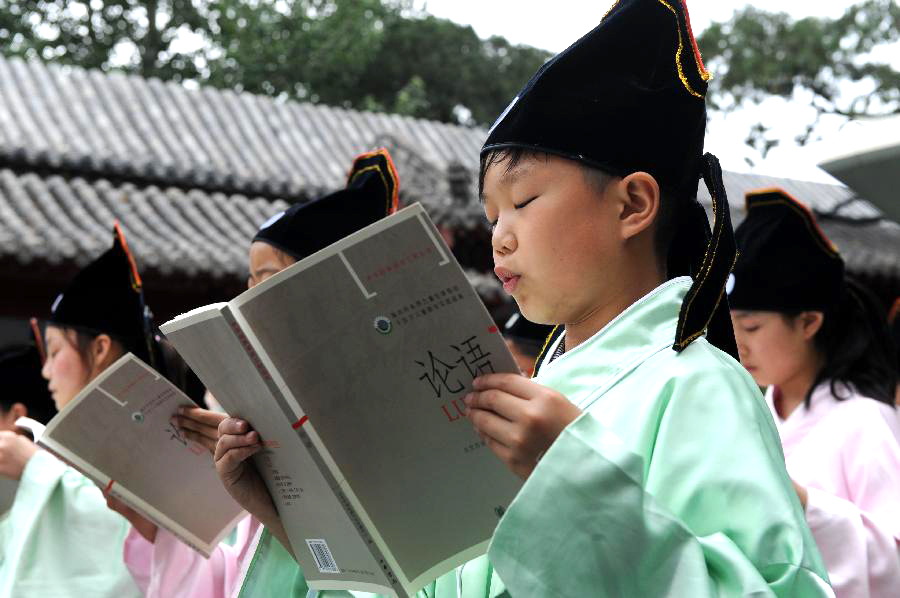Inclusiveness sustains Chinese civilization

Children reciteThe Analects, a classic Confucian text, at Songyang Academy in Dengfeng, Henan Province.
Chinese civilization has a long history, but there are disputes among scholars from home and abroad about whether it has sustained without interruption. Drawing upon historical facts, this article examines how to correctly address the position of Chinese civilization in world civilization.
In world history, there are four identified cradles of civilization: Mesopotamia, Egypt, the Indian subcontinent and China. While the three other civilizations ended one after another due to invasion and conquering by alien races, only the Chinese civilization survived. When one dynasty took over power from another in Chinese history, it did not destroy the previous one as a whole. It instead inherited, transformed and developed the previous one.
Although Chinese civilization has suffered from internal strife and external threats through times, it has lasted approximately 5,000 years. No Western civilization can claim to succeed directly from the other three civilizations.
Confucian civilization
In the history of world civilization, three civilizations formed based on three beliefs or ideologies, which even now are still influencing many regions, nations and countries: Confucian civilization, Christian civilization and Islamic civilization.
Christian civilization originated from the underclass in Jewish communities during the Roman Empire in the 1st and 2nd century. Its cultural significance has undergone many changes in the 2,000 years to today due to social changes. Nowadays, Christian civilization means more than just Western capitalist civilization.
The Prophet Muhammad created Islam in the year 622. During the 7th and 8th centuries, Islam spread quickly around the world and made a global impact. Its dynamics for development derived from the cultural elements of the Jewish, Greece-Rome and Persia-Mesopotamia traditions. Now, it is still the mainstream civilization in many regions, nations and countries in the world.
Confucian civilization originated in China and spread to Japan, the Ryukyu Islands, Korean Peninsula, Indo-China Peninsula and other East Asian regions and countries. In modern times, Western civilization intruded into the Asia-Pacific region amid colonial expansion, bringing changes to the East Asian civilization. Nevertheless, it is impossible to alter or erase Confucian civilization because its cultural elements have taken root and penetrated cultural genes, people’s psychology and social customs in relevant regions and countries.
Therefore, Confucian civilization has lasted longest among the three ancient civilizations. All of them have sustained without interruption.
Unity and inclusiveness
Why has the Chinese civilization sustained until today with such strong vitality? Its strength can be attributed to its inherent unity and inclusiveness. The Chinese civilization is based on China’s Central Plains (zhongyuan) culture, which absorbed and assimilated cultures from other races and minorities all over China. The kernel part of Chinese civilization, namely Confucianism, places emphasis on li with the aim of preserving social order, stability and harmony. Together with measures of unifying the written language and creating the legal system by rulers, Chinese civilization fostered great internal unity which promoted its integration and development.
Another reason that the Chinese civilization has sustained without interruption is its geographical conditions and interaction between the Central Plains and surrounding races. Ancient China was situated at the eastern end of Eurasia, with the Siberian Tundra to the north, the Pacific to the east, desert to the northwest and mountains to the southwest. China was protected by natural barriers.
Races surrounding the Central Plains in ancient China lagged behind in terms of social and economic development with their smaller populations. There were cases when surrounding races invaded and dominated the Central Plains and changed people’s thinking, production mode, behavior and customs. However, the major trend was that these races were influenced by the Central Plains. Chinese civilization became even more diversified and vigorous after taking in cultural elements from these races.

 PRINT
PRINT CLOSE
CLOSE